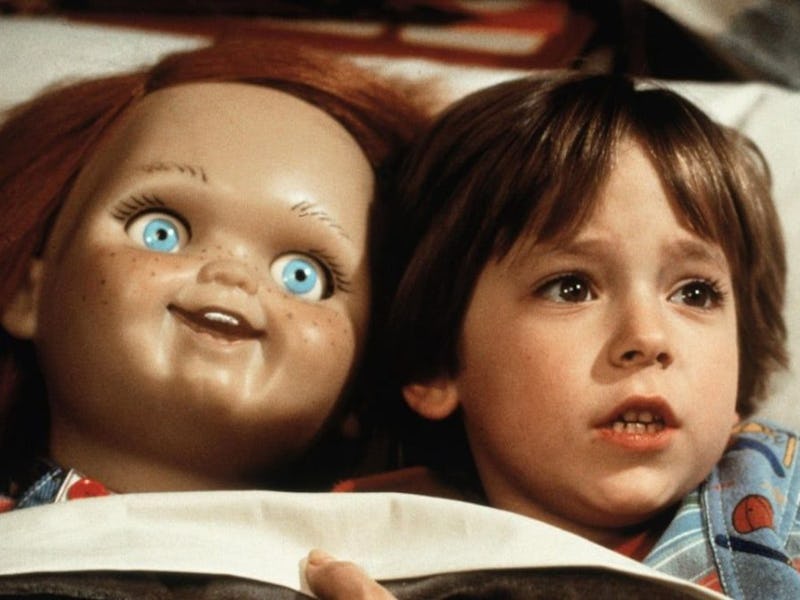Forget Michael Myers and Freddy Krueger. Chucky is Horror’s MVP.
While not as iconic, Chucky can brag about a remarkable string of hits.

Gorehounds watch slashers for the kills. They don’t watch them for consistency. Slasherdom’s dregs have their proponents; everything is someone’s jam, even I Still Know What You Did Last Summer and Halloween 5: The Revenge of Michael Myers.
But consistency is a merit worth beating a drum for, the invisible kind viewers don’t immediately notice yet gravitate toward all the same. In the big bloody bucket of horror franchises, what floats to the top for sheer constancy is Tom Holland’s Child’s Play, the story of Chucky, a Good Guy doll gone Very Bad on account of sadistic serial killer Charles Lee Ray’s (Brad Dourif) in-depth voodoo knowledge. Thirty-five years, six sequels, one USA Network show, one ill-conceived reboot, and a documentary later, fans can pick their favorite without worrying about quality. On the strength of series author Don Mancini’s assured screenwriting, all the Child’s Play movies are good.
That’s an amazing achievement for any series, regardless of its genre. Contextualized in horror specifically, Child’s Play’s rock-steadiness is a rare feat verging on preternatural. Lots of horror films stink. It’s what makes horror fans great movie fans: they spend a lot of time sorting treasure from tripe, so they tend to have a nose for finding the good stuff and an appreciation for the bad stuff. They don’t ironically love trash. They love trash because it is trash, the same way Oscar the Grouch loves the threadbare sneaker his mother gave him on his birthday.
Child’s Play spares audiences the pain of a single bad entry. You don’t need to watch all the films to distinguish the ones that suck from the ones that don’t. You just need to watch them to know which ones you like the most. (Lars Klevberg’s clumsy 2019 reboot, divorced from Mancini’s oversight and talent, is the exception that proves the rule.) Child’s Play 3 has that terrific haunted house ending; Seed of Chucky takes a stab at the gender binary and sports that S-tier John Waters face melt; Curse of Chucky introduces Fiona Dourif to the series as Nica Pierce, a new wrinkle in Chucky’s gruesome black comic saga; Cult of Chucky stages the absolute worst way to die in the entire franchise.
No matter which film anyone calls their number one, everyone knows to give homage to the original, whose elegantly simple hook established the groundwork for almost four decades of superb horror. Ray, bleeding out and on the run from Chicago PD Detective Mike Norris (Chris Sarandon), ducks into a toy store for cover and a change of appearance; one voodoo chant later and Ray’s body lies dead in the aisles by a Good Guy doll, now serving as the receptacle for his soul.
Or what’s left of it.
Meanwhile, it’s young Andy Barclay’s (Alex Vincent) birthday, and all he wants is a Good Guy. All Ray wants is a suitable human host to transfer his soul into. By the rules of voodoo, he has to choose the first person he reveals his identity to, which, of course, is Andy, who would rather not be body-swapped by a murderer. So begins Andy’s tenure as Chucky’s longstanding nemesis. Andy, for his part, is doing just fine apart from the years of psychological trauma suffered from being hunted by a bloodthirsty doll. Chucky, however, could be doing better, mostly because his nefarious plans are usually foiled, and because he’s such a miserable people person that allies turn against him as often as they turn to him.
The legendary Dourif is one reason for Child’s Play's enduring cohesion. As Robert Englund is to A Nightmare On Elm Street, a likewise uniformly good horror series with a few meaningful bumps, so is Dourif to Child’s Play. A recognizable and anchoring presence, his performance as Chucky stitches together spirited mischief to utmost menace, expressing clearly how much Ray, whether in the flesh or in fabric, loves killing. But Dourif has a benefit few other slasher icons have, and that’s Mancini.
It takes a very specific and very impressive kind of talent to consistently sell horror this ridiculous.
Mancini holds the sole screenwriting credit on every single Child’s Play film outside of Child’s Play itself, which he shares with John Lafia and Holland; he also directed the most recent three. This cannot be said of Wes Craven and the Nightmare movies, John Carpenter and the Halloween movies, or the Friday the 13th movies, which hardly have any repeat business on the directing, writing, or producing side.
Craven’s and Carpenter’s legacies are cemented in A Nightmare on Elm Street and Halloween, not their sequels, and with other directors handling them, these masters of the genre busied themselves shooting future classics like The People Under the Stairs and The Thing. Mancini and Child’s Play never developed the same association between title and name as Craven and A Nightmare on Elm Street, and Carpenter and Halloween. Instead, they built the foundation of the horror series that’s never missed.